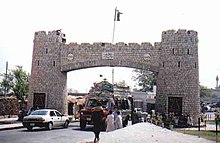What well-known mountain pass connects Pakistan and Afghanistan?
The Khyber Pass (Pashto: د خیبر درہ, Urdu: درۂ خیبر) is a mountain pass in the northwest of Pakistan, on the border with Afghanistan. It connects the town of Landi Kotal to the Valley of Peshawar at Jamrud by traversing part of the Spin Ghar mountains. An integral part of the ancient Silk Road, it has long had substantial cultural, economic, and geopolitical significance for Eurasian trade. Throughout history, it has been an important trade route between Central Asia and South Asia and a vital strategic military choke point for various states that came to control it. The summit of the pass is 5 km (3.1 mi) inside Pakistan at Landi Kotal, while the lowest point is at Jamrud in the Valley of Peshawar. The Khyber Pass is part of Asian Highway 1 (AH1).
In a number of editions of the Indo-Aryan Migration Theory, the Indo-Aryans began relocating to India through the Khyber Pass. Well-known invasions of the area have been predominantly through the Khyber Pass, such as the invasions by Cyrus, Darius I, Genghis Khan and later Mongols such as Duwa, Qutlugh Khwaja and Kebek. Prior to the Kushan era, the Khyber Pass was not a widely used trade route.
The Khyber Pass became a critical part of the Silk Road, which connected Shanghai in the East to Cádiz on the coast of Spain.The Parthian and Roman Empires fought for control of passes such as these to gain access to the silk, jade, rhubarb, and other luxuries moving from China to Western Asia and Europe. Through the Khyber Pass, Gandhara (in present-day Pakistan) became a regional center of trade connecting Bagram in Afghanistan to Taxila in Pakistan, adding Indian luxury goods such as ivory, pepper, and textiles to the Silk Road commerce.
Among the Muslim invasions of the Indian subcontinent, the famous invaders coming through the Khyber Pass are Mahmud Ghaznavi, and the Afghan Muhammad Ghori and the Turkic-Mongols.
Finally, Sikhs under Ranjit Singh captured the Khyber Pass in 1834 until they were defeated by the forces of Wazir Akbar Khan in 1837. Hari Singh Nalwa, who manned the Khyber Pass for years, became a household name in Afghanistan.
To the north of the Khyber Pass lies the country of the Mullagori tribe. To the south is Afridi Tirah, while the inhabitants of villages in the Pass itself are Afridi clansmen. Throughout the centuries the Pashtun clans, particularly the Afridis and the Afghan Shinwaris, have regarded the Pass as their own preserve and have levied a toll on travellers for safe conduct. Since this has long been their main source of income, resistance to challenges to the Shinwaris’ authority has often been fierce.
For strategic reasons, after the First World War the British built a heavily engineered railway through the Pass. The Khyber Pass Railway from Jamrud, near Peshawar, to the Afghan border near Landi Kotal was opened in 1925.
During World War II concrete “dragon’s teeth” (tank obstacles) were erected on the valley floor due to British fears of a German tank invasion of British India.

Bab-e-Khyber, the entrance gate of the Khyber Pass
The Pass became widely known to thousands of Westerners and Japanese who traveled it in the days of the hippie trail, taking a bus or car from Kabul to the Afghan border. At the Pakistani frontier post, travelers were advised not to wander away from the road, as the location was a barely controlled Federally Administered Tribal Area. Then, after customs formalities, a quick daylight drive through the Pass was made. Monuments left by British Army units, as well as hillside forts, could be viewed from the highway.
The area of the Khyber Pass has been connected with a counterfeit arms industry, making various types of weapons known to gun collectors as Khyber Pass copies, using local steel and blacksmiths’ forges.
Credit:https://en.wikipedia.org/wiki/Khyber_Pass


Leave an answer
You must login or register to add a new answer.